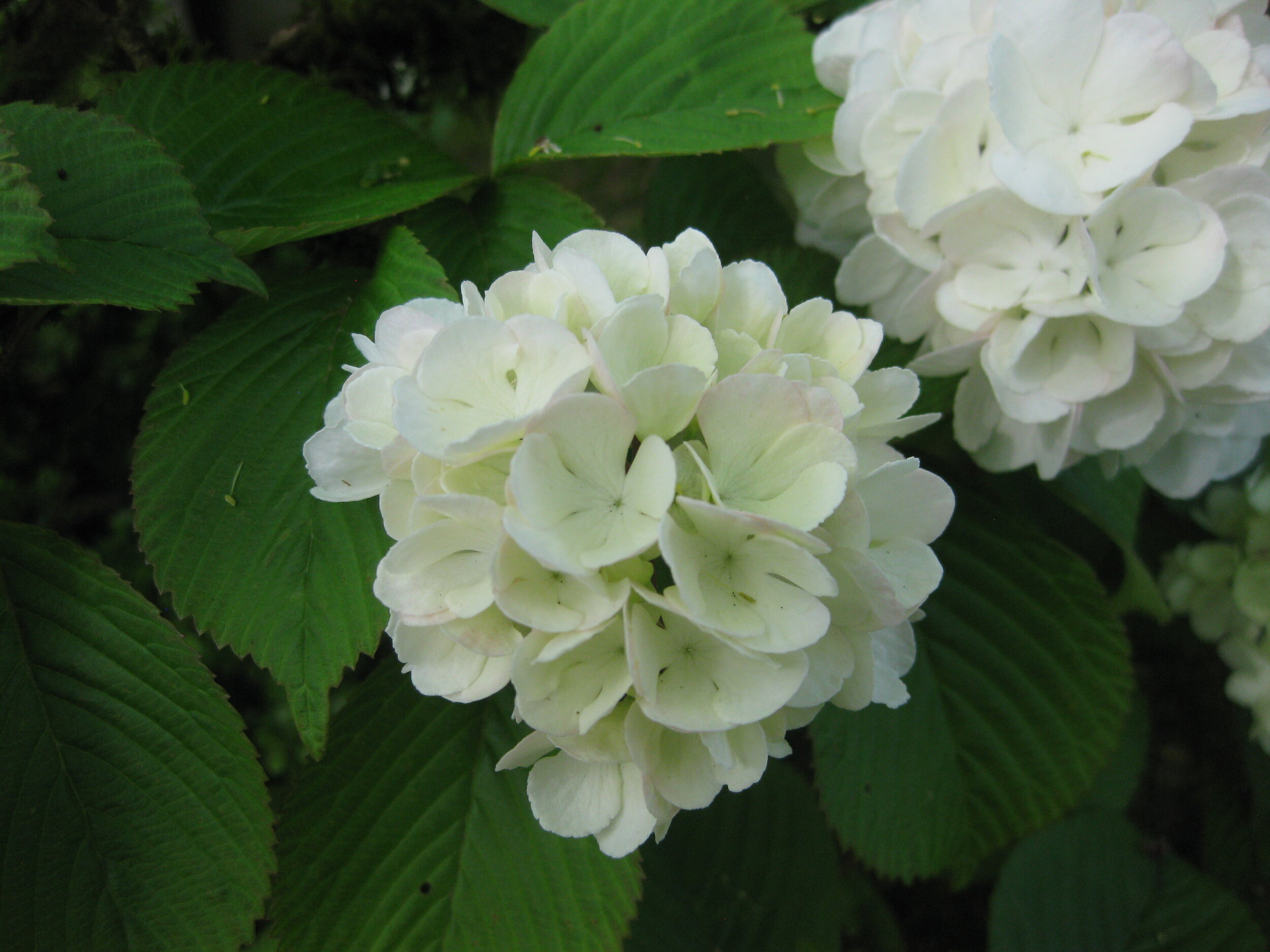In Bloom: Two Forms of Viburnum plicatum Have Showy White Flowers in Spring
By Corinne Kennedy
Flat-topped flower clusters of doublefile viburnum. (photo: Peganum. Licensed under Creative Commons Attribution-Share Alike 2.0)
Viburnum is an important genus of woody plants, with more than 150 species – some of treelike proportions, but most with a shorter shrub-like habit. Almost all are multi-season plants, appreciated for white, creamy white or pink spring flowers, attractive fruits and/or striking fall color. Some are evergreen, but the majority are deciduous.
The Seattle Japanese Garden has three species, but the loveliest is Viburnum plicatum, which is native to China, Taiwan & Japan. The wild form, Viburnum plicatum f. tomentosum (sometimes known as Viburnum plicatum var. tomentosum) grows on the islands of Honshu, Shikoku and Kyushu – in open woodlands, on thicket-covered slopes and along rivers. Known as yabu demari in Japan, it was introduced to the West in about 1865. The common name, doublefile viburnum, references how the flowers are held in double rows above the branches. The species name, plicatum, means “pleated” and refers to the prominent veining of the leaves. The form/variety name, tomentosum, acknowledges the short downy hairs covering their undersides.
Doublefile viburnum is a four-season deciduous shrub with an attractive layered structure, elegant white flowers, and striking fall color – and one of my favorite flowering shrubs! Its mature size is about 10 feet tall, spreading much wider with time. The horizontal branching habit is lovely and distinctive. Four-inch wide, white, flat-topped flower clusters (cymes) open in late April or May, and are held on two-inch stems in double rows above the branches. With a center of small fertile flowers surrounded by an outer ring of larger and very showy sterile flowers, they resemble lacecap hydrangea blooms. Like most hydrangeas, they lack fragrance. Fruits, when they appear, are oval red drupes, becoming black at maturity. They attract many species of birds.
Fall color of Viburnum plicatum f. tomentosum. (photo: Botanical Garden, Berlin, November 2005. Licensed under Creative Commons Attribution-Share Alike 3.0)
Leaves emerge early and are held opposite along the stem. Dark green, 2 to 4 inches long, broadly egg-shaped and toothed, they have prominent veins. They angle downwards, so flowers and fruit remain prominent. Fall color is an attractive wine-red.
Doublefile viburnum in Area K, pruned to a low, horizonal habit. (photo: Aleks Monk)
Hardy to USDA Zone 5 (minimum temperature -20 to -10 degrees F), Viburnum plicatum f. tomentosum performs best in light shade, in fertile, well-drained, slightly acid soils of medium moisture. It has no major pests or diseases other than cankers that sometimes form on the branches of old plants, easily controlled by pruning. It adapts well to soils of various pH, and tolerates sandy or clay soils if drainage is adequate. In the Pacific Northwest it thrives in full sun except under conditions of extreme heat or extended drought. Invasive in some parts on the Eastern U.S., it is not considered problematic in Washington State.
Many cultivated varieties have been developed, including ‘Mariesii’, ‘Shasta’ and ‘Summer Snowflake’, which are well-known and generally available at retail nurseries.
The Seattle Japanese Garden has three plants located along the pond – one in Area K and two in Area Q. All are pruned low to reveal their essential horizontal habit and to keep them in balance with their surroundings. Annual shaping maintains their five-foot height and open structure.
The snowball-shaped flowers of Viburnum plicatum f. plicatum. (photo: Aleks Monk)
A sterile, cultivated form of Viburnum plicatum also grows in our garden. Viburnum plicatum f. plicatum (sometimes known as V. plicatum ‘Sterile’) is unknown in the wild but has long been cultivated in Japan, where it is known as o demari. The English common name is Japanese snowball bush, a reference to its showy snowball-shaped flowers.
This cultivated variety (cultivar) was discovered by European botanists before their discovery of the wild fertile form, Viburnum plicatum f. tomentosum. The unfortunate result was that the cultivar was named as if it was the “species type” – even though species plants must be fertile forms capable of reproduction. To add to the confusion, a completely different viburnum species, Viburnum opulus ‘Roseum’ (European snowball) is also named for its snowball-shaped flowers.
Japanese snowball bush, blooming in Area F. (photo: Aleks Monk)
The two forms of V. plicatum are similar in their cultural requirements and in most other respects, including foliage and fall color. Differences include plant habit, hardiness, flower and fruit. The Japanese snowball bush is more upright in habit, often maturing taller than doublefile viburnum, and is slightly less cold hardy. Its sterile, snowball-shaped flowers open about 2-3 weeks later, and look like small mophead hydrangea blooms. About three inches wide, they are tinged greenish before changing to snow white. Lacking fertile flowers, plants do not set fruit. Available cultivars include ‘Grandiflorum’ and ‘Newport’.
I’m grateful that one of the loveliest species of Viburnum is planted in our Seattle Japanese Garden – both the wild form of Viburnum plicatum (forma tomentosum) and its sterile cultivar (forma plicatum). Their beautiful flowers remind me of hydrangea blooms, but unlike most hydrangeas these two forms of Viburnum plicatum are beautiful in all seasons. Both have elegant white flowers in spring, handsome pleated disease-free leaves that turn wine-red in fall, and striking branch architecture. In my own garden, two ancient plants – sited along property lines and maintained as informal espaliers – bring me pleasure throughout the year.
Corinne Kennedy is a Garden Guide, a frequent contributor to the Seattle Japanese Garden blog, and retired garden designer.





